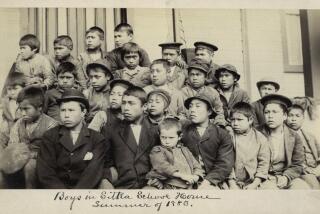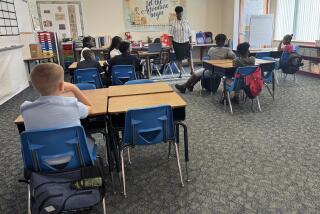Florida school exhumations revive ghosts of a grisly past
The men remember a manicured campus stained by the blood of teenage boys. They remember the explosion of the leather strap â 30 lashes, 50 lashes, more than 100 â and the bloody classroom chairs they scrubbed down later.
For more than a century, the Arthur G. Dozier School for Boys in the Florida Panhandle town of Marianna took in damaged children and turned out shattered men.
The state closed the school in 2011 after the U.S. Justice Department documented some of the abuse. But the sprawling campus may still be hiding horrors.
On Saturday, researchers began excavating the grounds in search of graves. Records show that 96 boys died at the school between 1914 and 1973. Among them were 20 who died from influenza and pneumonia and eight who burned to death in a locked dormitory.
Just how many bodies are buried there is unclear. A team of researchers from the University of South Florida used ground-penetrating radar last year to detect 50 bodies. But that was 19 more than officially accounted for. The excavations, which continue until Tuesday, promise to rewrite patchy records and have drawn attention from across the state.
Among those waiting to see what the work reveals are three people with special ties to the school: Jerry Cooper, who watched a classmate die; Erin Kimmerle, who conducts research on societyâs most vulnerable; and Ovell Krell, who wants Florida, after all these years, to let her bury her brother.
A young witness
At 2 a.m. one night in 1960, a 15-year-old quarterback for the Dozier School for Boys football team was sleeping in Roosevelt Cottage when two men woke him up. They wanted information about a boy who had fled the school, a ârunner.â
Soon, Jerry Cooper was being dragged in his nightgown to the White House, a small concrete chamber where boys were beaten. A leather strap sliced through the dank air and slashed his back. Later, Cooper would remove pieces of nightgown from his torn, purple skin. A boy in another room counted 135 lashes.
âThey thought this would heal some troubled boys,â said Cooper, now 68. âBut it turned a lot of men into monsters.â He still battles anger problems that led to an arrest record nearly 40 assaults long.
In August, Cooper drove 500 miles from his home in Coral Gables to Tallahassee, where he watched Gov. Rick Scott and the state Cabinet vote unanimously to allow researchers to dig on school grounds.
The work may turn up a friend, Edgar Elton, who stopped breathing feet away from Cooper during a football practice. Elton had asthma and told Cooper that instructors forced him to practice even though a doctorâs note prohibited him from playing.
Cooper, who is white, says he knows only half of what happened at the school. White and black students were segregated until 1968, heirs to a history of discrimination in Marianna that some trace to a Civil War victory there by black Union soldiers.
A black student and friend of Cooper, Johnnie Walthour, recalled being asked to dig a grave for a friend who was beaten to death. They made Walthour pull plows âjust like a mule,â he said.
That kind of abuse wasnât uncommon in parts of northern Florida well into the 1900s, Cooper said. In 1934, residents of Marianna famously lynched a black farmhand, Claude Neal, who was suspected of killing a white woman.
Cooper hopes the exhumation offers victimsâ families closure. But heâs just as eager to unearth a period of racial violence he says too many have ignored.
âItâs gonna get nasty.â
A civil rights story
Erin Kimmerle reads history in buried bones. A forensic anthropologist at the University of South Florida, sheâs studied the aftermath of atrocities in Nigeria and Kosovo.
Now the leader of the universityâs excavation team, Kimmerle is digging for more than forensic evidence; she also wants people to remember how Florida once discarded its boys.
âCemeteries are a reflection of who we are as a society,â she said. And criminal justice in Florida, she said, was conducted as a for-profit operation.
Until 1923, Florida practiced the convict lease system, an arrangement with origins in the Reconstruction-era South that provided largely black prisoner labor to private bosses for a fee. âItâs been described as modern-day slavery,â Kimmerle said.
The school sold 20,000 bricks a day, all produced by students. In 1921, one superintendent had students cut timber on his private land, then sold the timber to the school for over $9,000.
Kimmerle said itâs easy to forget an era when the state could handle criminals for profit and hide its bodies. âTo be buried in unmarked graves and lost to time and place doesnât register to most of us.â
And yet it happened, one chapter in a longer-running drama. âThis is a story of civil rights,â she said.
A sisterâs grief
Ovell Krell was 12 years old when her older brotherâs body was buried somewhere at the reform school in 1941. Officials said Owen Smith had escaped Dozier and died while hiding under a house in Marianna. That story never sat right with his sister.
âI knew it then, I know it now,â Krell said. âI donât think a 14-year-old boy is going to crawl under a house and lay there to die.â
Owen left home one day in 1940, maybe heading to Nashville to play his guitar, but Krell is only guessing. His parents got word that he had been arrested in Tavares, Fla., charged with stealing a car even though he didnât know how to drive. He was hauled to Dozier after a hearing to which his parents were never invited.
Owen wrote to his parents, once saying heâd been hauled back to campus after trying to escape: âI got what was coming to me.â
Then Owen stopped writing. Frantic letters from his mother, Frances Smith, went unanswered. When the superintendent replied that Owen was missing, Smith threatened to pay a visit.
She never saw her son. A day before she arrived, the family was told Owen had been found under a house, his body decomposed. An invitation to retrieve his body was rescinded when police said heâd accidentally been buried already. Krell knew this wasnât how it was supposed to work.
Smith stopped cooking and cleaning, and practically quit raising her children. âShe never was my mom hardly at times,â Krell said. Krellâs own grief hardened quickly, and she took up the task of raising her younger siblings.
Now 84, Krell is sober and reserved, grateful for the excavation work but doubtful her brother will ever be identified. Sheâs a former police officer and a realist.
And then abruptly, in a telephone interview, the cop persona gave way to that of a desperate sister hoping for news. Krell echoed her momâs doubts that Owen was really dead: âWe never knew â we donât know till now, even.â
More to Read
Sign up for Essential California
The most important California stories and recommendations in your inbox every morning.
You may occasionally receive promotional content from the Los Angeles Times.










